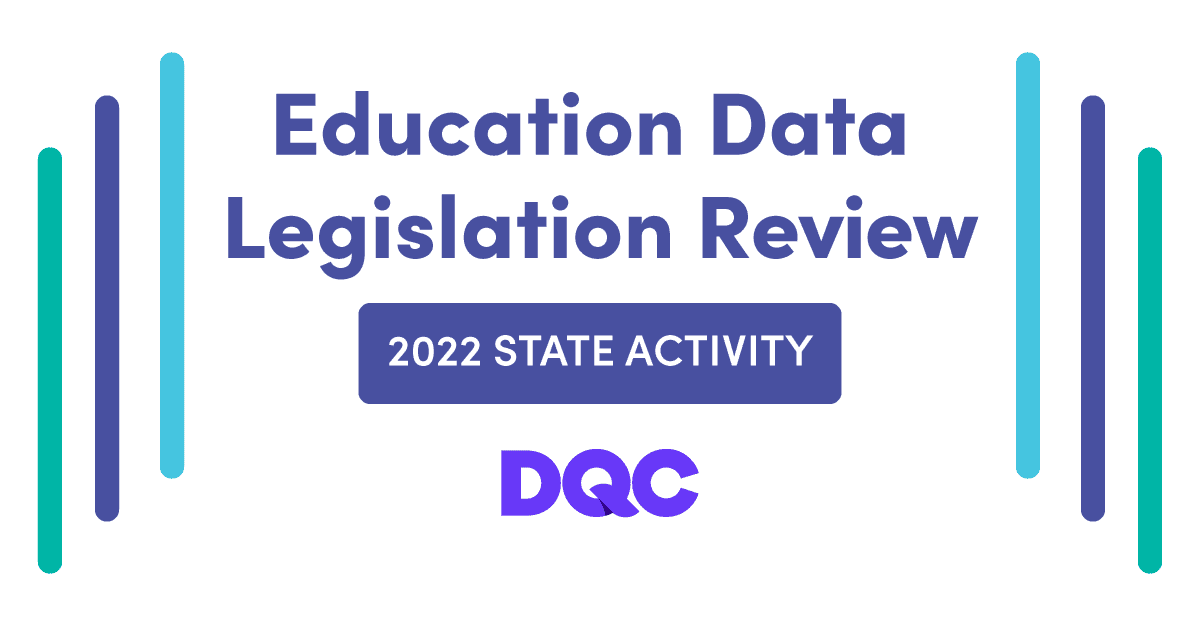New DQC report analyzed 131 bills in 35 states that would govern the use of data along the early childhood to workforce continuum
WASHINGTON (October 11, 2022) – Each year, state legislators craft new policies that drive data use across their states. As part of a comprehensive review of state education data legislation, the Data Quality Campaign (DQC) tracked 131 bills in 35 states—42 of which became law in 17 states—that would govern the use of data from early education through K–12, postsecondary, and the workforce. This year’s data-related bills addressed two realities:
- People need data. More than half of the bills included provisions that would make new or existing state data available to nonpolicymaker audiences, including students, families, and the public.
- To understand and address emerging issues, state leaders have new data needs and policy goals. Most commonly, legislators focused on understanding students’ K–12 learning experiences beyond academics and supporting post–high school transitions.
“Over the last few years, we’ve seen state leaders introduce and pass legislation aimed at ensuring that data is available to address the education and economic impacts of the pandemic. In 2022, state legislators continued that trend by making investments in their state’s data systems and creating policies to ensure that everyone has access to data that supports decisionmaking,” said DQC President and CEO Jennifer Bell-Ellwanger. “In 2023, legislators must continue this work with investments in statewide data infrastructure that ensure that state data systems provide the resources that individuals need to use data to make decisions.”
During the 2022 legislative session, we saw bills that included encouraging practices, areas in which to proceed with caution, and provisions to avoid because they will prevent legislators from meeting their goals. Some state legislative efforts pursued the following encouraging practices:
- Cross-agency data governance: Seven bills incorporated data governance provisions, which create clear processes for decisionmaking about data, including requiring agency leaders and other potential data users to come to a shared table to make these decisions.
- Community feedback: Seven bills incorporated feedback requirements as part of new data initiatives this year. Gathering feedback from potential users builds trust with those audiences and helps state leaders ensure that investments in data meet the needs of the individuals they intend to serve.
- Data disaggregation: Twenty-six bills required some form of data disaggregation—critical for decisionmakers to be able to identify opportunity gaps and the supports that are needed to ensure that all students have equitable access to education.
- Clarifying data privacy policies to account for new practices: Seven bills sought to clarify data privacy policies to account for new practices this year. State leaders should regularly revisit existing student data privacy policies to determine where updates need to be made to account for changes in technology and classroom data use.
Too often, legislation contains noteworthy data efforts that can quickly slip into compliance-oriented, box-checking exercises. This year, we saw bills that could have become box-checking exercises but incorporated the following policies and practices that make the legislation stronger:
- New data collections: Generating new data to answer state questions is necessary and important, but legislators should consider how to ensure that new data is high quality and can be put to work to meet data goals. Steps to make sure new data collections are useful include providing data definitions and designating funding to support these new collections. Of this year’s bills, 120 required new data collections or updates to existing ones.
- Reporting requirements: Making data publicly available is important, and reporting requirements have long been a common policymaker tool. When generating reporting provisions, legislators can convey their intention for making public data useful by articulating the conditions for how data should be published, with a focus on ensuring that the data is easier to find, use, and understand. Forty-nine of this year’s bills established new public-facing data.
In some cases, legislative efforts as written will not move states toward data goals and may even move states backward. Efforts of this kind should be avoided:
- Local data use mandates without state support or community engagement: New requirements must be bolstered by investments as well as the level of community support that comes with engaging potential data users throughout the planning and implementation processes.
- Overly narrow privacy policies: Legislators should focus on other policy approaches that empower parents and protect privacy, such as ensuring parents have a clear understanding of their existing opt-out rights and supporting schools and districts to establish data governance policies that maintain transparency about how student data is protected.
“As state legislators work to create new data collections and provide access to that information, data collection and transparency mandates must be paired with support for state data systems,” said Bell-Ellwanger. “It is paramount that states implement policies to ensure that high-quality, linked data is available from early education through the workforce, and that it is available to all individuals who need it to make decisions about their futures.”
Read DQC’s full analysis of the 2022 legislation session.
###
About the Data Quality Campaign
The Data Quality Campaign is a nonprofit policy and advocacy organization leading the effort to bring every part of the education community together to empower educators, families, and policymakers with quality information to make decisions that ensure that students excel. For more information, go to dataqualitycampaign.org and follow us on Facebook and Twitter.


